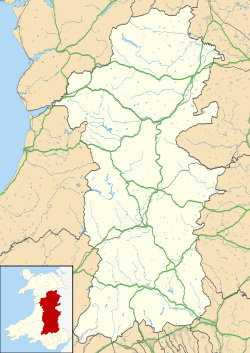
160th (Welsh) Brigade or Brigâd 160 (Cymru), is a regional brigade of the British Army that has been in existence since 1908, and saw service during both the First and the Second World Wars, as part of the 53rd (Welsh) Infantry Division. It is a regional command responsible for all of Wales. The Brigade is also regionally aligned with the Eastern European and Central Asian regions as part of defence engagement.
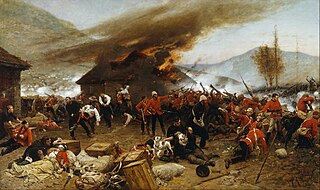
William Wilson Allen, VC was an English recipient of the Victoria Cross (VC) for his actions at the Battle of Rorke's Drift in January 1879, the highest and most prestigious award for valour in the face of the enemy that can be awarded to British and Commonwealth forces.

The South Wales Borderers was a line infantry regiment of the British Army in existence for 280 years.

The 52nd Lowland Volunteers is a battalion in the British Army's Army Reserve or reserve force in the Scottish Lowlands, forming the 6th Battalion of the Royal Regiment of Scotland, also known as 6 SCOTS. Due to its erstwhile association with the 1st Regiment of Foot, it is the senior Reserve line infantry battalion in the British Army. It is one of two Reserve battalions in the Royal Regiment of Scotland, along with 51st Highland, a similar unit located in the Scottish Highlands.

The 7th Light Mechanised Brigade Combat Team is a formation in the British Army with a direct lineage to 7th Armoured Brigade and a history that stretches back to the Napoleonic Wars. It saw active service in the Crimean War, the Second Boer War and both the First and the Second World Wars. In 2014, the 7th Armoured Brigade was re-designated as 7th Infantry Brigade, thereby ensuring that the famed "Desert Rats" continue in the British Army's Order of battle.
Joseph Henry Russell Bailey, 2nd Baron Glanusk,, was a British Army officer and peer.
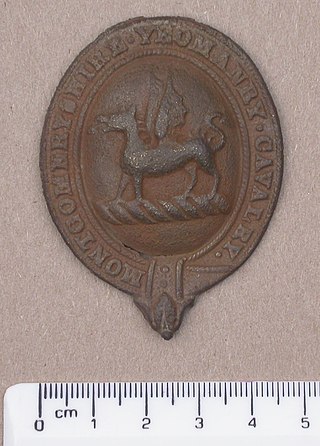
The Montgomeryshire Yeomanry was a Welsh auxiliary unit of the British Army first formed in 1803. It served in home defence and for internal security, including deployments to deal with Chartist disturbances in the 1830s. It provided volunteers to the Imperial Yeomanry during the Second Boer War and formed three regiments for service during World War I. It was broken up and converted to infantry and artillery in 1920.
The 113th Brigade was an infantry brigade formation of the British Army active in both the First and the Second World Wars.

The 115th Brigade was an infantry brigade formation of the British Army raised during both the First and Second World War.
The 224th Brigade was a Home Defence formation of the British Army in World War I and World War II. It existed under several variations of the 224th Brigade title.

The Monmouthshire Regiment was a Territorial infantry regiment of the British Army. Originating in units of rifle volunteers formed in Monmouthshire in 1859, the regiment served in the Second Anglo-Boer War and both World War I and World War II before losing its separate identity in 1967.
The South Wales Brigade was a Territorial Force infantry brigade of the British Army. Formed in 1908, it was not part of any division, instead serving as Army Troops, though attached to the Welsh Division in peacetime. It was dissolved in early 1915 as its constituent battalions were posted to other formations.

The Poyser Street drill hall is a former military installation in Wrexham, Wales.
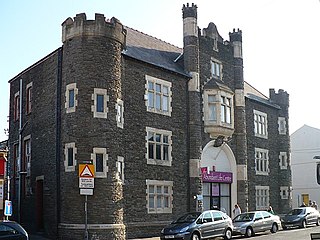
The Lower Dock Street Street drill hall is a former military installation in Newport, Wales.

The Baker Street drill hall is a former military installation in Abergavenny in Wales.
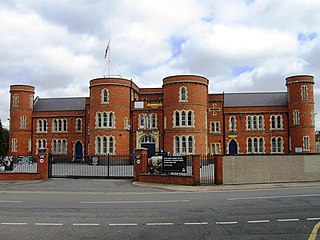
The Clare Street drill hall is a military installation in Northampton, Northamptonshire. It is a Grade II listed building.
The 3rd (Volunteer) Battalion, The Royal Regiment of Wales was an infantry battalion of the British Army, part of the Royal Regiment of Wales. The battalion was formed during the expansion of the Territorial and Army Volunteer Reserve (TAVR) in 1971, and later disbanded and merged with the 4th (V) Battalion of the same regiment to form the new 2nd (V) Battalion. The battalion's lineage is currently carried on by two company-sized units: C Company, part of the 3rd Battalion, The Royal Welsh and 580 (Glamorgan) Transport Squadron of 157th Regiment, Royal Logistic Corps.
The Brecknockshire Militia, later the Royal Brecknockshire Rifles, was an auxiliary regiment reorganised from earlier precursor units in the Welsh county of Brecknockshire during the 17th Century. Primarily intended for home defence, it served in Britain and Ireland through all Britain's major wars. After a series of shortlived mergers it was finally amalgamated into the Royal South Wales Borderers Militia in 1876. This regiment's title and headquarters at Brecon were adopted in 1881 when the South Wales Borderers (SWB) was formed as the local regiment of the Regular Army. The battalion saw active service during the Second Boer War. It became at Special Reserve battalion of the SWB and trained thousands of recruits for the fighting battalions of the regiment during World War I. After 1921 the militia had only a shadowy existence until its final abolition in 1953.
The Brecknockshire Battalion was a Welsh unit of the British Army's auxiliary forces. First raised in 1859, it became a Volunteer Battalion of the South Wales Borderers. During World War I it served in garrison at Aden, where it was engaged in the Battle of Lahej. It was amalgamated with another battalion in the 1920s but regained its independence in time for World War II, when it served in home defence and supplied reinforcements to the forces fighting overseas. Postwar it was reformed as a light anti-aircraft regiment of the Royal Artillery and was one of the founder units of today's 104th Regiment Royal Artillery in the Army Reserve.

